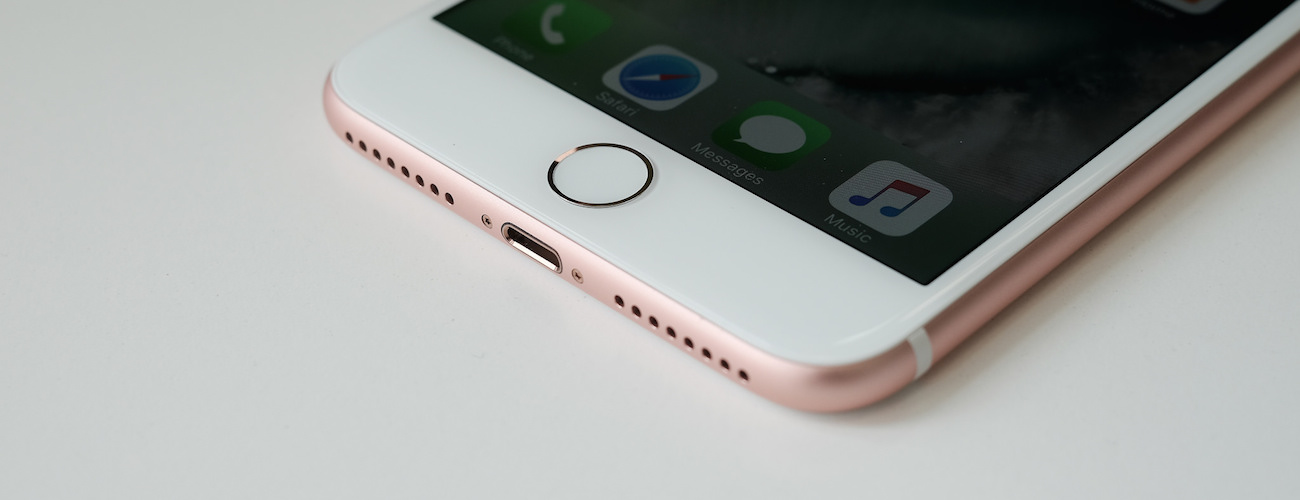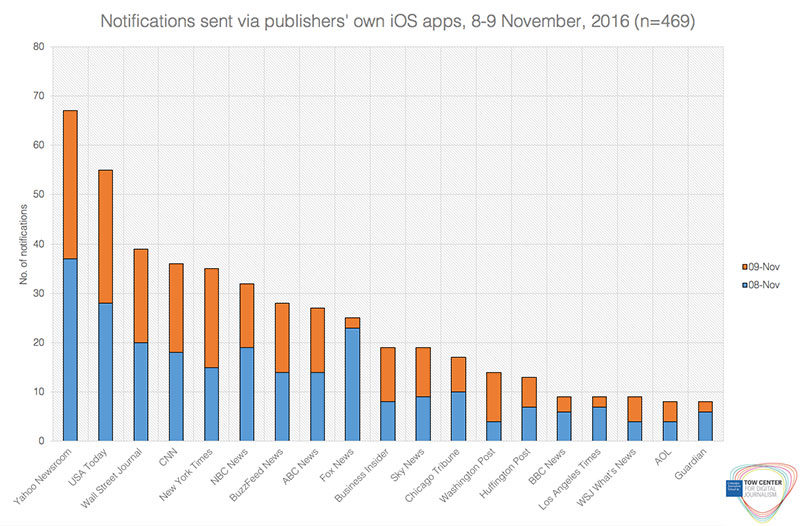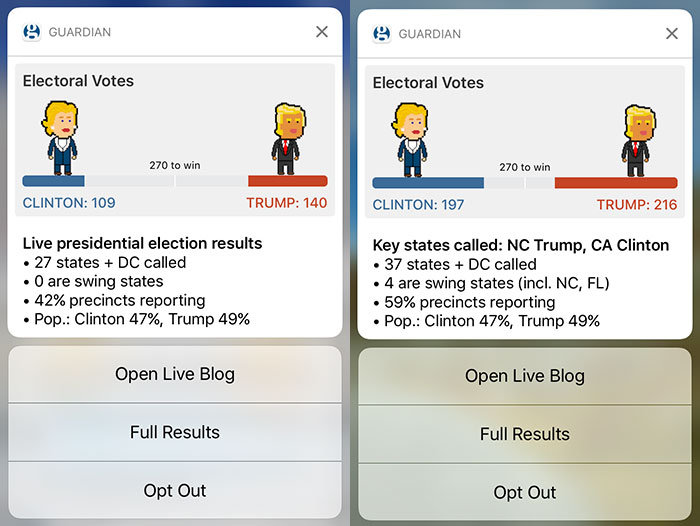Sign up for the daily CJR newsletter.
More Americans than ever this year learned about Election Day results from their phones, including via mobile push notifications news organizations deployed in brand-new ways.
According to data collected by the Tow Center for Digital Journalism as part of a larger project examining the role of push notifications in the digital strategies of 23 publishers, 469 notifications were sent on Election Day and the day following. There was a large amount of variation in how frequently notifications were used: Yahoo News sent out more than 60 over the 48-hour period, while the Wall Street Journal sent out fewer than 10.
Image: Tow Center for Digital Journalism. Click here for a larger version.
Meanwhile, notifications themselves have gained many new features in the past few months alone. The new iOS on iPhone allows publishers to embed media, such as videos and images, in an expanded notification on the lock screen. Some publishers are experimenting with presenting images and even emojis in the push notification. Mic, for instance, has started adding videos.
The Guardian Mobile Innovation Lab is working within this changing territory, experimenting with how to dish out Guardian content on mobile in the hopes of furthering industry standards.
On Election Day, the Lab worked with the Guardian app teams to set up an automatically updating push alert that refreshed with new numbers throughout the night for users who opted in. Instead of sending multiple notifications, users saw a single notification sitting on the phone’s lock screen, which could be expanded into a visualization of the electoral count. It included information about electoral votes, swing states, the popular vote, and percent of precincts reporting.
Image: Guardian Mobile Innovation Lab.
Normally, notifications are a way to drive traffic and engagement on the news site’s mobile app: a simple line of text that allows the user to swipe through to see the full story. One might expect an informative notification might discourage the flow of traffic to the Guardian app, since it provides all the basic information right on the home screen, thereby depriving The Guardian of a pageview. But the team did not see this effect; out of 230,000 subscribers to the alert, they generated over 800,000 pageviews to the Guardian live blog and full results. And 75 percent of users tapped through at some point.
They also conducted a survey afterward, which returned favorable reviews from 6,054 users, 70 percent of which reported expanding the notification to see the visualization. Their results are encouraging for those building interactive notifications. The notification did not buzz after the initial notification, but users tapped through throughout the night anyways, showing “notifications from news organizations can be extremely useful without having to be intrusive,” said Sarah Schmalbach, product manager at the Lab.
The Guardian Mobile Innovation Lab is also working to develop other tools. Sasha Koren, the editor, said in an email they are exploring what “what live coverage would look like if it was built mobile first.” For instance, when it comes to breaking news or sports events, news sites often rely on live blogs. But, added Koren, “they were really built for desktop, beginning in the early 2000s.”
The Lab is also working on building readers’ locations into their experience. “If we were granted permission to your location, could we give you a package of stories if we see that you’ve landed in a new city, or a set of options for how you get news during your commute?” Koren wrote. Tailoring notifications to location is also something The New York Times is doing, by customizing alerts to specific countries, as Digiday’s Jessica Davies reported.
We are sure to see more experimentation as newsrooms grow more savvy with presenting content on mobile phones. The Lab’s work may be a crucial contribution, especially post-election, facilitating conversations about how to deliver content so it reaches readers. Perhaps David Bozell, president of conservative nonprofit ForAmerica, said it best in an interview with Times reporter John Herrmann: “It’s Marketing 101: Go to where people are at.” Which is, more often than not, their lock screens.
Has America ever needed a media defender more than now? Help us by joining CJR today.











